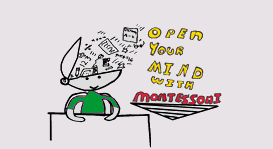What is the Montessori Method?
Montessori is a philosophy or method of education that recognizes in children a natural curiosity and desire to learn. Certified Montessori directresses and special Montessori teaching materials encourage this curiosity into a learning experience. Dr. Montessori perceived the years from birth to six years as a period when a human being showed the greatest potential towards learning. For this "sensitive period" in a child's life Dr. Montessori designed the "prepared environment" where, "...the child, set free from undue adult intervention, can live its life according to the laws of its development." The Montessori directress, the Montessori equipment, and the prepared environment all stimulate and encourage the child to learn. Children enjoy using Montessori materials as they learn not just by memorizing, but by associating an abstract concept with a concrete sensorial experience.
What are Montessori Materials?
The prepared environment of the Montessori classroom is supplied with didactic (self-teaching) materials which can be manipulated by the children. The materials are designed to foster independence, develop a healthy self-concept, encourage thinking and give an appreciation of nature and the world. The prepared environment includes the following five areas: Practical Life, Sensorial, Language, Math and Cultural. The Sensorial exercises are comprised of a series of objects which are grouped together because they share a physical, palpable quality such as size, shape, sound or color. Each piece of sensorial material is designed to emphasize one salient quality but in different degrees which are perceptually observable. Learning to perceive minute differences between objects is an important byplay of the sensorial apparatus. To train a child's senses is to create an astute observer. Practice at judging, classifying and discriminating gives a perceptual "alphabet" with which a child can organize their mind and world. Montessori sensorial materials offer a wealth of concrete objects to manipulate which sequentially lead to abstract concepts. This is a long process but the sensorial equipment provides "materialized abstractions" that are the ground work for the concepts of number and numeral. The sensorial area gives the child a perceptual idea of basic mathematics. It is indirect preparation for the mathematics area, language area (sound discrimination, visual perception,eye-hand coordination) and the cultural area (awareness of classification).
Some web site:
The Canadian Council of Montessori Administrators
http://www.ccma.ca/montessori.html
North American Montessori Teacher's Association
http://www.montessori-namta.org/NAMTA/geninfo/whatismont.html
The Montessori Foundation
http://www.montessori.org/story.php?id=307 (Youtube Story)
Montessori - The International Montessori Index
www.montessori.edu
